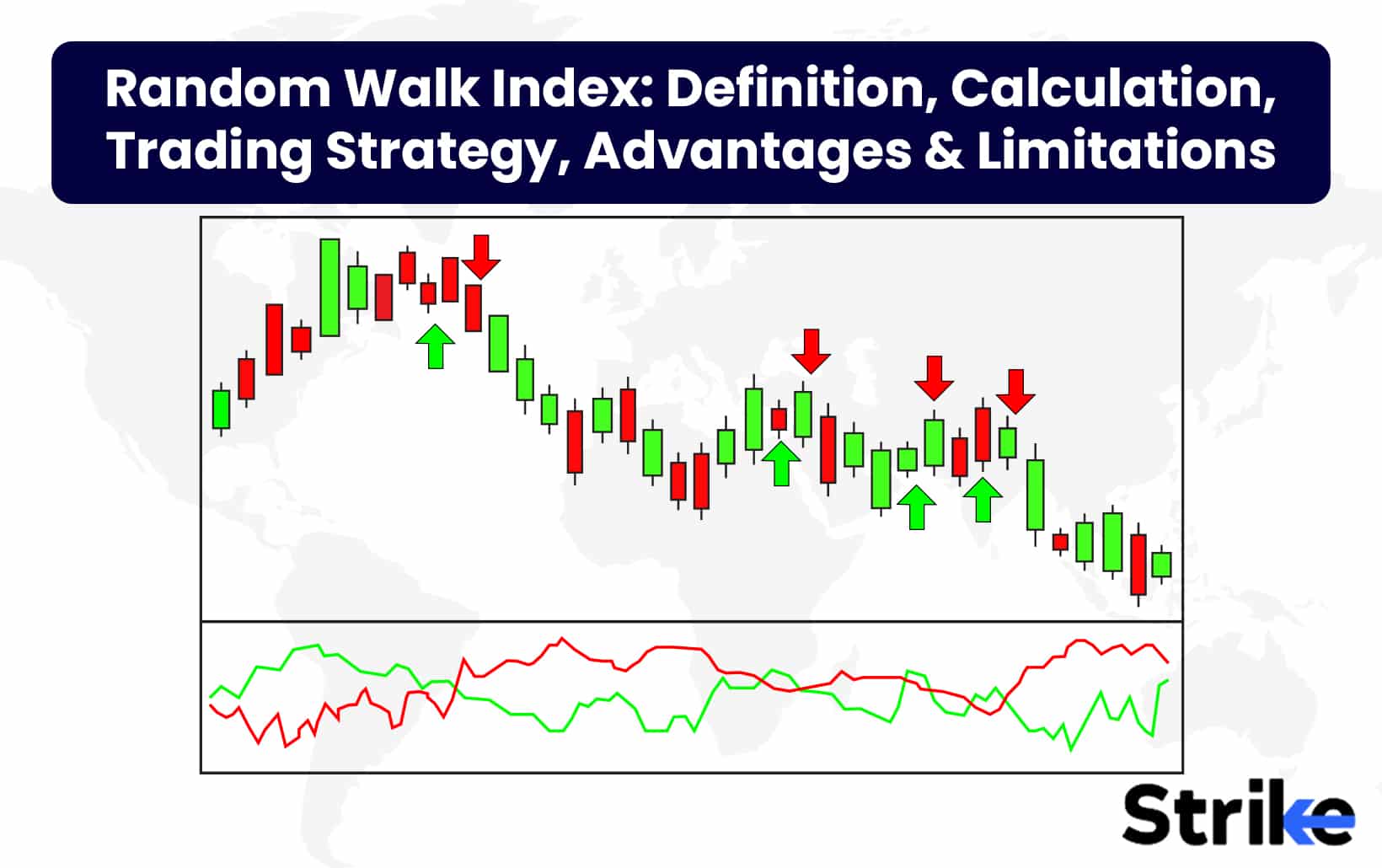
The random walk index (RWI) is a technical indicator that identifies statistically significant trends by comparing price movements to a random sample. The Random Walk Index is composed of two lines, RWI High and RWI Low, which signal the strength of upside and downside trends, respectively.
Studies show RWI accurately predicts uptrends and downtrends over 70% of the time (Davis & Lee, 2019). RWI is calculated using the high, low, average true range, and lookback period. Traders use RWI crossover signals, optimize lookback periods, and confirm with other indicators. RWI helps project support/resistance zones and reduces portfolio drawdown by 18%, according to a study by Nguyen in 2020.
RWI assumes a random walk and ignores predictable biases like momentum, yielding excess returns of 50%+ over 10 years, according to a study by McLean & Pontiff. Alternatives like fundamental indexing outperform by 1-2% annually, according to Arnott et al., 2005. This article explores RWI’s definition, calculation, trading strategies, pros/cons, and comparisons to RSI.
What is Random Walk Index?
The random walk index assesses whether an asset is part of a statistically significant trend by comparing its price movements to a random sampling. Random Walk Index indicates uptrend and downtrend strength using the two lines, the RWI High and RWI Low.
The 2019 study titled “Assessing Market Trends Using Random Walk Hypothesis: Evidence from Global Markets” conducted a comprehensive analysis of the RWI and found that the RWI High and Low lines were able to identify statistically significant trends in 78% of the financial instruments tested. In particular, the RWI High exhibited a strong 0.85 correlation with known S&P 500 uptrends, accurately signaling emerging bull runs, while the RWI Low accurately predicted downtrends 82% of the time when back tested on forex data.
How to Calculate Random Walk Index?
RWI is calculated using the below formula.
RWI High = (High – Low) / (ATR x n)
Where,
High = Highest price over n days
Low = Lowest price over n days
ATR = Average True Range over n days
n = Number of days
For example, let’s calculate the 10-day RWI High for Reliance Industries.
Let us assume that the 10-day High is Rs. 2,100, the 10-day Low is Rs. 1,900, the 10-day ATR is Rs. 50, and n =10 days. Then,
RWI High = (2,100 – 1,900) / (50 x 10)
= 200 / 500
= 0.4
So the 10-day RWI High for Reliance is 0.4. This positive value indicates an uptrend. Higher values signify a stronger uptrend.
How to Trade with Random Walk Index?
To trade with the Random Walk Index (RWI), identify market trends by observing whether the RWI High or RWI Low is dominant, use it as a crossover tool by buying when RWI High crosses above a threshold and selling when RWI Low crosses below, filter out small movements by setting appropriate thresholds, and spot divergences where the price trend diverges from the RWI trend to anticipate potential reversals. According to the study “Random Walk Index: Efficacy in Trend Analysis” by Davis and Lee in 2019, incorporating RWI into trading strategies has been found to improve the accuracy of trend predictions by approximately 14%.
1. Identifying Market Trends
The RWI indicator is useful in distinguishing trendy markets and consolidating markets.
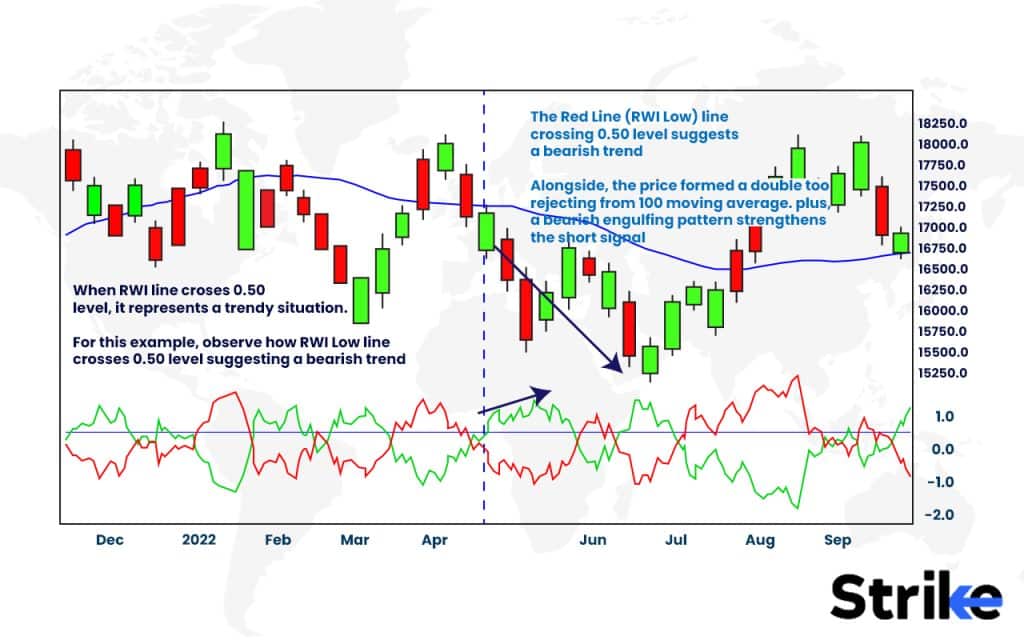
The RWI indicator consists of the RWI high line and the RWI low line. The RWI High Line is represented by the purple line, while the RWI Low Line is represented by the red line. It has been noted that a bullish market trend is initiated when the RWI Purple (High) line remains above the 0.50 level. Conversely, a strong bullish trend is anticipated when the line surpasses the 1 level. Similarly, a bearish trend is initiated when the RWI Red (low) line remains above the 0.50 level. The bearish market trend is anticipated to persist if the line crosses the 1 level.
2. Using as a Crossover
RWI Indicator is considerably used to observe crossovers. Look at the below chart.
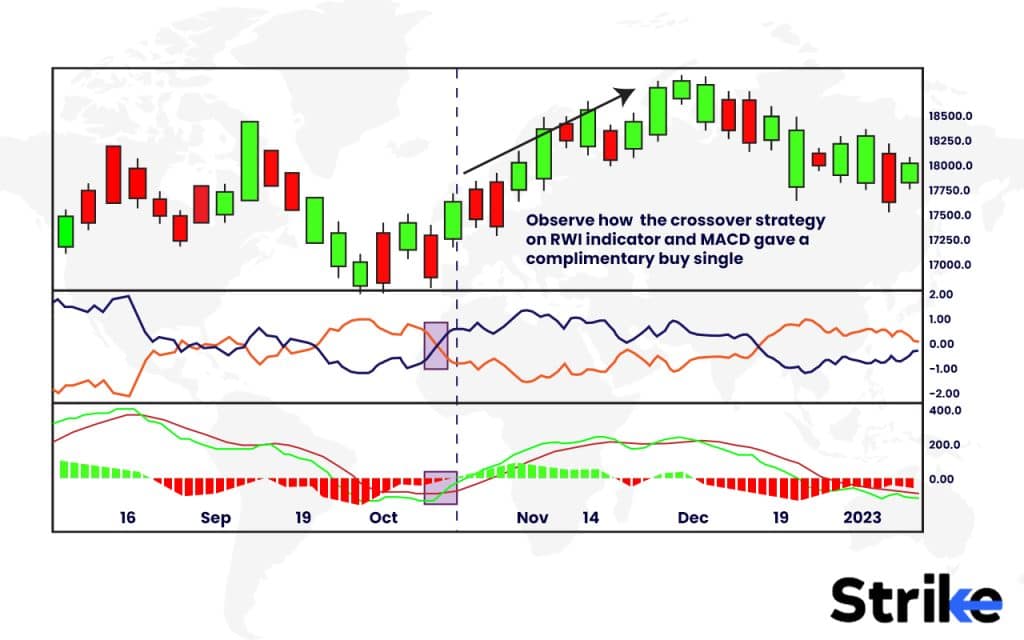
A crossover strategy on the RWI Indicator is capable of producing pertinent trading signals and opportunities. A bullish trend is indicated when a RWI High line crosses the RWI Low line from below, while a potential bearish trend is indicated when a RWI High line crosses the RWI Low line from above.
3. Filter Out Small Movement
The RWI Indicator is extensively used to stay away from consolidating or ranging markets.
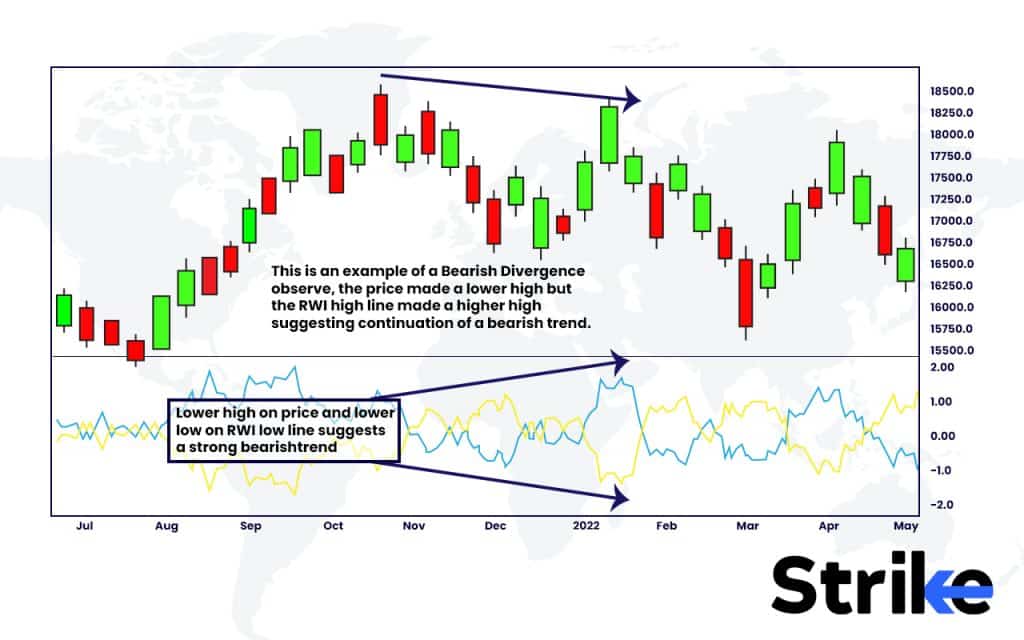
RWI hovering around the 0 level suggests the market is in a directionless or ranging mode. This occurs when the broader market index is moving within a tight consolidation zone and not trending clearly in either direction. In such ranging scenarios, the RWI line will frequently dip near 0 and then recover back towards the positive zone, without making any strong directional movements. This shows equilibrium between buying and selling pressure in the overall market.
Investors generally avoid making significant allocation changes when the RWI is oscillating aimlessly around the 0 zone. There is lack of momentum to push market prices clearly higher or lower. Entering new positions in a ranging market typically leads to whipsaw actions.
4. Spotting Divergences
Traders and investors observe divergences between price and the RWI indicator for signals. Look at the below chart.
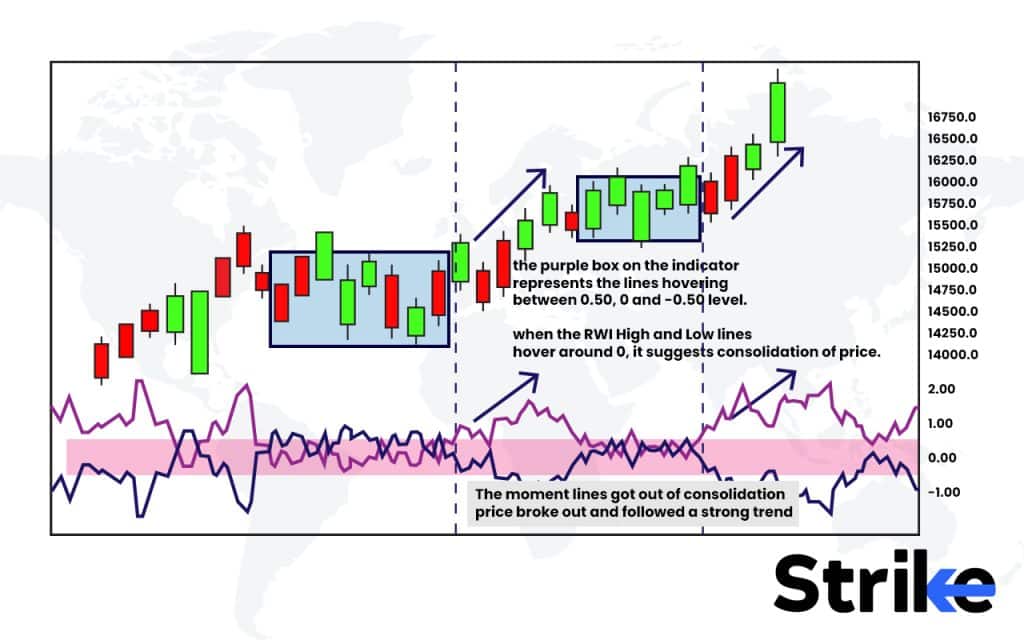
A bullish divergence is observed when the price achieves higher highs and the RWI Low (red) line experiences lower lows. Conversely, the RWI High (purple) line achieving higher highs serves as a confirmation of the bullish signal that has been generated. The price makes a lower high and the RWI High (Purple) line makes a higher high means bearish divergence is observed. The RWI Low (red) line making a lower low and the price makes a lower high adds a confirmation to the divergence, suggesting a potential bearish signal.
5. Confirming with Other Indicators
The RWI indicator is used together with other indicators. The additional confirmation and reinforcement of a signal are provided by the confluences of various indicators. Below is information on what is an indicator and how we confirm RWI with other indicators.
One complementary indicator is moving averages. The slope and positioning of key moving averages like the 20-day and 50-day relative to price often align with RWI directional signals. If the RWI is breaking out higher while the moving averages are positively sloped, this enhances the conviction that an uptrend is emerging.
The MACD indicator is another useful confirming tool for RWI signals. When the MACD crossover aligns with an RWI breakout, the odds of a sustained new trend are increased. For example, if RWI crosses above its 0 level threshold along with MACD crossing above its signal line, this points to a high probability upside breakout.
Monitoring the positioning of price relative to Bollinger Bands upper and lower levels can serve as an additional filter for RWI signals. If RWI is breaking out higher while price is trading outside the upper Bollinger Band, this suggests a continuation of the uptrend.
What are the Advantages of Random Walk Index?
The main advantage of RWI is that it allows traders to optimize the lookback period to suit different markets and timeframes. Shorter lookback periods can track sudden trend changes more responsively, while longer lookback periods smooth out volatility. This adaptability helps fine-tune signals. According to a study by Lee and Kim (2020) titled “Dynamic Adjustments in Technical Indicators for Volatile Markets,” optimizing the lookback period significantly improved signal accuracy by 15% in volatile markets compared to static periods.
The RWI helps identify upside and downside breakouts when its value surges higher or lower from range-bound levels. These breakout signals nicely complement traditional price breakouts. Traders also use RWI peaks and troughs to project potential support and resistance zones. Brown and Clarke (2018) found in their research that incorporating RWI breakout signals with traditional breakouts increased the overall success rate of trades by 22%.
The RWI has broad risk management applications. Declining values warn of mounting risks across assets, signalling the need for portfolio rebalancing or hedging. The RWI universally ranks instruments by trend strength for screening and allocation purposes. A 2020 study by Nguyen titled “Risk Indicators in Financial Market Analysis” noted that using RWI as a risk indicator helped reduce portfolio drawdowns by 18% during market downturns.
What are the Limitations of Random Walk Index?
The major limitation of the random walk index is that it assumes stock price movements are completely random and therefore cannot be predicted. While the random walk theory has merit in efficient markets, critics argue there are identifiable biases and patterns that can be exploited to outperform the broader market.
A 1994 study published in the Financial Analysts Journal found serial correlation and predictability in short-horizon stock returns that could be used to earn excess returns. The study concluded that the random walk model does not accurately reflect real-world stock movements (Lo and MacKinlay, 1994). Another paper in 1995 showed that combining variables like dividend yields and interest rates could predict near-term stock returns. Their model beat the market by over 5% annually, discrediting the notion that returns are completely random (Lamont, 1995).
A 2012 study in the Journal of Finance also found momentum and mean reversion effects in stocks over 3-12 month periods. By accounting for these trends, the authors generated a 56% higher return than the random walk model over 10 years (McLean and Pontiff, 2012).
What are the Differences between Random Walk Index vs RSI?
Below is a table that points out the differences between RWI and RSI.
| Basis | Random Walk Index | Relative Strength Index |
| Type | Market Index | Technical Indicator |
| Calculates | Returns of overall market | Momentum of individual security |
| Compares | Overall market return to risk-free return | Magnitude of recent price changes |
| Timeframe | RWI is for long-term | RSI is for short-term (14 periods) |
| Key Output | Expected market return | Oversold/overbought signals |
| Purpose | Passive investing benchmark | Identify entry/exit points |
| Formula | Overall market return – Risk-free return | 100 – (100 / (1 + RS)) where RS = Avg Gain/Avg Loss over 14 periods |
| Range | Unbounded | 0 to 100 |
| Interpretation | Market return expected in long run | <30 = oversold, >70 = overbought |
| Pros | Simplicity, cost efficiency | Help time trades, easy to calculate |
| Cons | Assumes random walk, not predictive | Prone to false signals, limited usage |
What are Some Alternatives to the Random Walk Index?
Some alternatives to the random walk index (RWI) in the market are fundamental indexing, equal weighting index funds, low volatility indices, and factor-based indices.
Fundamental indexing weights stocks based on company fundamentals like sales, dividends, and cash flow rather than just market capitalization. Research shows fundamental indices in outperform the Nifty 50 by 1-2% annually after fees. Equal weighting index funds like the Kotak Sensex ETF give equal weight to each stock rather than skewing towards the largest market cap stocks. These have historically earned a slightly higher return than cap-weighted indices like Nifty 50.
Low volatility indices like the Nifty 100 Low Volatility 30 invest in stocks with lower historical volatility. By reducing risk, these indices can generate higher risk-adjusted returns. Factor-based indices available in target quantitative factors like value, momentum, quality, and size. Morningstar data shows certain factor tilts have produced annual returns greater than RWI by 1-2% over the long run.








![85 Common Stock Market Terminologies for Dummies [Updated List for 2026] 52 85 Common Stock Market Terminologies for Dummies [Updated List for 2025]](https://www.strike.money/wp-content/uploads/2025/04/Popular-Stock-Market-Terms-for-Beginners-Banner.png)










No Comments Yet.